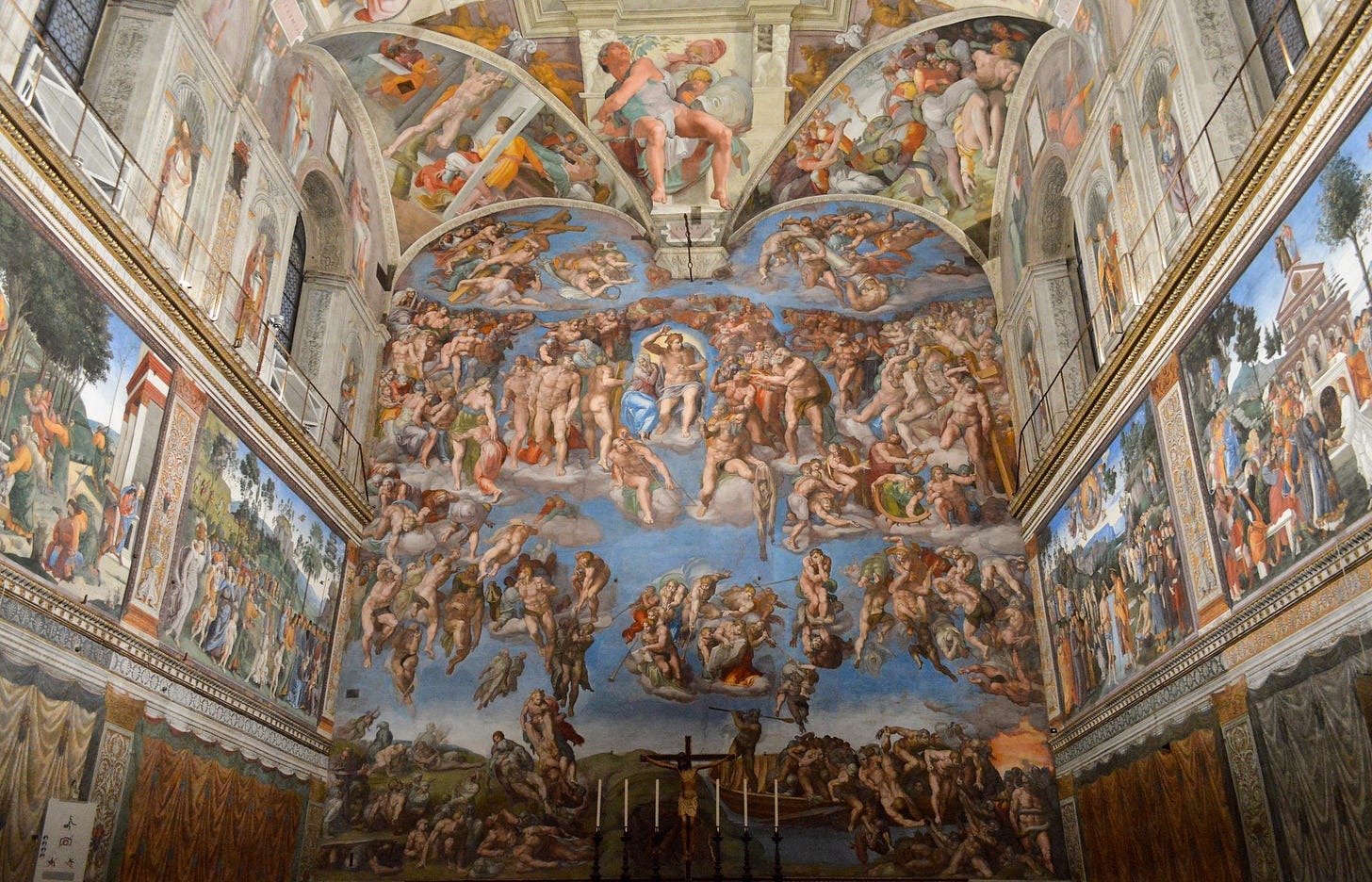Art Is For The People. Here's How To Dig In
Beauty isn't for the experts alone! The list below shows that if we’d like to delve deeper, the knowledge to do so is readily available.
Fine art is for the masses. That’s why it adorns our better public buildings and informs the design of our greatest fountains and public parks. Our greatest buildings are themselves fine art. And that’s why, when they wanted to reach the uneducated and often illiterate people of Europe, the Catholic Church chose art. Many of the world’s most famous works, such as the ceiling of the Sistine Chapel, were commissioned for this mission.
(“The Last Judgement,” in the Sistine Chapel of Vatican City, by Michelangelo. Photo by Francisco Anzola/Flickr.)
Yet today, the cult of modern art has combined with the cult of expert knowledge to the exclusion of popular education, enrichment, and enjoyment. So much of this modern “art” seems impenetrable, because it is, and too many of us fear that even humanity’s greatest works belong to the critics, not regular people like ourselves.
But beauty is for everyone! The list below shows that if we’d like to delve deeper, the knowledge to do so is readily available. We hope you enjoy.
Christopher Bedford
Executive Editor
Essential Reads (In Order To Learn About Fine Art)
Art and general aesthetics
Roger Scruton: The Aesthetic Endeavour Today
Sir Roger Scruton sees two forms of modernism in art. One form portrays itself as visionary and ahead of its time, disrespects the present, and aims to “constantly give offense” to modern sensibilities. Modernism’s other form, exemplified by artists such as T.S. Eliot, wants to “recapture” and “restore” tradition. This saner form of modernity in art respects the past and relies on the artistic brilliance perfected by past masters. It capitalizes on their artistic fruit to tell us something new about the present. Read The Aesthetic Endeavour Today to fully appreciate Sir Roger’s thoughts on how we can redeem modernity and create beautiful art.
Bruce Cole: The Informed Eye
The Informed Eye is Bruce Cole’s catalog of Western art’s greatest marvels of painting, sculpture, and architecture. Cole describes not just each work’s beauty and technique, but shows how each is a window into the artists’ lives and historical eras. This journey through Western art history will give you a deeper appreciation of the civilizations that produced such beautiful works, from Ancient Greece to the Renaissance courts of Europe.
Mark Helprin: Against the Dehumanization of Art
Mark Helprin contends that an artist’s role is to “work with what was given, to pay homage to God and nature,” and to “do another take on what God had already created.” Modernism, in contrast, is a destructive philosophy that sees no inherent purpose in the world. Artists in a world without meaning play God and create their own meaning. For Helprin, modernism produced bad paintings, literature, and poetry, but far worse was its promotion of ruinous nihilism that led to “a century of a hundred million dead in war, holocaust, and purge, and the general degradation of art and life.”
Poetry
Dana Gioia: Poetry as Enchantment
Carmen, Dan Gioia tells us, is the Latin word for poetry, and also the word for “a song, a magic spell, a religious incantation, or a prophecy.” Poetry’s magical power—its enchantment—is what Gioia explores in this essay. This power lowers our defenses, seizes our souls, summons “powerful images,” and awakens “deep emotions.” Intellectually analyzing poetry has its uses, but it also robs us of much of poetry’s emotional enchantment and its appeal to new generations. Fortunately, Gioia offers some ways our society can restore poetry’s popularity.
Painting
Tom Wolfe: The Painted Word
Tom Wolfe’s ridicule of modern art doesn’t pull any punches. The Painted Word walks us through a collection of absurdities masquerading as art, such as an almost-blank canvas or a painfully-detailed description of toast. Wolfe’s acerbic wit skewers modern art’s purveyors, by painting them as self-important hypocrites who claim to disdain society even as they deeply crave its praise. The drive to assuage guilty feelings about their wealth by supporting poor, bohemian “starving artists” motivates contemporary art’s patrons far more than any true appreciation of artistic genius. Modern art deserves to be mocked, and Tom Wolfe does a superb job.
Dianne Durante: How to Analyze and Appreciate Paintings
Art is both a “source of contemplation and joy” and of “inspiration and spiritual fuel.” If we are to reap these rich rewards, we must understand art’s underlying message, its “theme.” Dianne Durante offers some questions to help us draw out that theme: what details catch your eye immediately upon seeing a painting? Why did the painter use one color and not another? What is revealed about the theme in the landscape, or the way illumination is used? She then applies this investigative method to two famous Renaissance masterpieces to demonstrate her technique. Even if you’re a novice, Durante’s engaging method will help you see paintings with new appreciation.
Literature
Italo Calvino: Why Read the Classics?
It’s hard to define a “classic,” but Italo Calvino provides fourteen definitions to prove to us that we need classic books. Reading a classic helps us define our own personalities in relation to the author, show us that old books can still influence our world even after they’re seemingly been forgotten, and remind us that “Every rereading of a classic is as much a voyage of discovery as the first reading.” If you need a good motivation to finally pick up that copy of War and Peace or revisit your paperback of The Count of Monte Cristo, this is it.
Homer: The Iliad
In his essay above, Calvino recommends “the direct reading of [a work of literature] itself” instead of reading others’ commentaries on it. And what better way to start than with Homer’s Iliad, one of Western literature’s foundational works. This legendary story of Troy’s downfall, of how pride can hurt those we love the most, of how war ruins all before it, humanizes the ancients by demonstrating how humanity always struggles with the same challenges, whether in the Bronze Age or in the 21st century. Homer shows war’s tragedy and heroism and human depravity’s deepest depths, as well as touching moments of kindness and mercy. Read this epic poem to see why it has captivated readers for thousands of years.
Music
(Daniel Bernard Roumain plays violin in Portland, Maine. Photo by Paul VanDerWerf/Flickr.)
Michael Walsh: Who’s Afraid of Classical Music?
“How should you listen to classical music? And why?” Michael Walsh answers this question in a witty, funny, and instructive style that’s both educational and entertaining. Classical music may be intimidating, but Walsh’s approachable and irreverent tone demystifies it; everyone can learn to appreciate it. This book defines some basic musical terms and gives us detailed musical recommendations, interspersed throughout with character profiles of history’s most legendary composers, including Bach, Mozart, and Beethoven. Who’s Afraid of Classical Music? is a fun, captivating way to learn about classical music while falling in love with it.
Sculpture
Irving Stone: The Agony and the Ecstasy
Irving Stone’s historical novel focuses on the life of Michelangelo, one of history’s greatest sculptors. It follows Michelangelo’s footsteps as he chisels and paints the famous masterpieces that still today draw crowds of admirers into Italy. This novel provides a fascinating look into this legendary artist’s life, the arduous process of carving marble, and Renaissance Italy’s political intrigues.
Dianne Durante: Getting More Enjoyment from Art You Love
In “Getting More Enjoyment from Art You Love,” Dianne Durante applies the approach she developed in her other essay on this list to teach the reader how to approach sculpture. She looks at two equestrian statues: one showing George Washington’s quiet dignity and magnanimity and the other depicting the legendary Spanish hero Cid as a brave and fierce leader ready to charge into battle. This essay touches on similar ideas: art can inspire us to perform great deeds and serve as an “emotional fuel” for our actions, and this fuel is harnessed when we improve our skill at analyzing it. As Durante says, “To get the most out of a work of art, we must approach it with an active mind….Heightened awareness gives rise to heightened enjoyment—and the reward is well worth the effort.”
Architecture
Sir Roger Scruton: Confessions of a Heretic: Building to Last
If ugly modern architecture leaves you cold and you’re interested in learning how we can design more beautiful buildings, read Sir Roger’s essay, “Building to Last.” Part of his larger Confessions of a Heretic collection, this essay laments modern “starchitects” who design flashy, ugly buildings that cheaply call attention to themselves instead of harmoniously fitting into their surrounding neighborhood. Sir Roger relies heavily on the work of visionary architect Léon Krier when making his case. Krier’s dream was to design beautiful cities that actually feel like homes. Sir Roger shows us how this vision is an antidote to the ugly urban sprawls that we suffer today.






